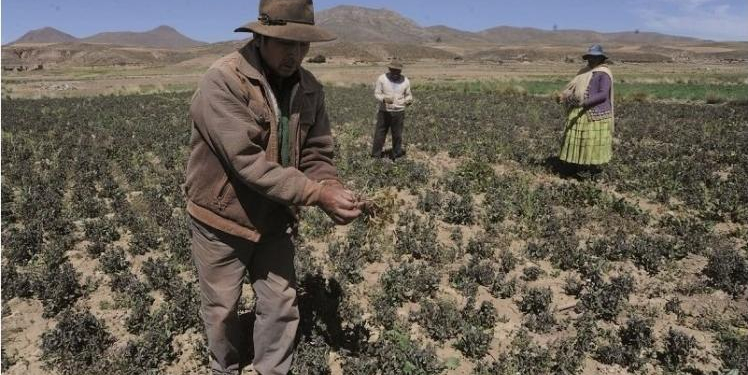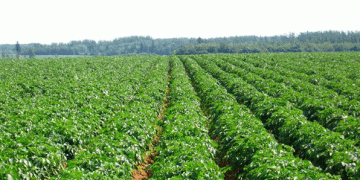Some 300 producers have lost their seedings to the unexpected natural phenomenon; the locals will ascend to the hill of San Martín to beg for the storm rainfall.
“Naqantatawa (everything burned)”, laments in Aymara Lucia Guarachi when she seeds of beans, peas, alfalfa and onion that frost shattered Tuesday morning in the canton Villa Concepción Belén, in the municipality of Patacamaya, 95 kilometers from La Paz. There, some 400 hectares (ha) of agricultural production from four communities were hit by the extraordinary natural phenomenon.
“When the sky is heavenly and accompanied by a button, it is a sign that there will be frost and that happened this week,” warns Esteban Tola, another commune. Some 300 producers live in these four areas and at least 600 people are engaged in agricultural activity.
Guarachi, who this year was possessed as a Cargo Agent, a kind of rural meteorologist, instructs locals to “attack straw and whatever can be done to scare off the frost, but this year neither could save us,” he says.
The production of potatoes, onions, carrots, peas, beaks and even chard reaches more than 60 abastos in the city of El Alto, others sell their products also in the city of La Paz. These products are most appreciated because they are irrigated with uncontainted summit waters.
In early October a first frost fell, though not so strong, because the small plants of peas, beans and alfalfa resisted, but now the second frost was fatal. “I’ve even been told that I’ve brought bad luck, you can’t tell me that. What can I do if the frost comes?” asks the woman as a chick while showing the dried leaves of the small plants of damaged peas, beas and alfalfa.
As she walks amid these dry plantings, the soil is part in two because of the lack of moisture. “At this time all the land had to be green for the first harvests of January, but now we have lost everything,” cries Catalina Huarayo, another commune. It hasn’t rained in that region for more than two months.
At every step in Villa Concepción Belén you can see how the low temperatures ended up flipping over bean, pea, onion and even carrot plantings, in some cases.
It’s as if someone burned the sows with fire until they’re defeated on the floor. “This can no longer be saved, we will only have to rip them off to feed the sheep,” says Antonio Ticona, another 71-year-old peasant who so far can’t believe how the frost came in November.
Lucia Guarachi prays every night that the frost does not return, but she also has the match ready to set the fire and scare off the phenomenon and if there is a threat of hail, she will light firecrackers to also scare it away. In the paceño plateau it is believed that the stronger the roar of the firecracker, the rays with which the hail comes will escape, but it is not always so.
“I don’t know if frost has been a punishment, I don’t know what’s going on,” admits the peasant leader of others perhaps to the effects of climate change. Two weeks ago hails the size of an egg shattered planted in municipalities of Betanzos, Chaquí, Puna and Ckochas.
The Potosine Governorate committed aid to the peasants. In Patacamaya they hope that the Governorate of La Paz can help these producers in the face of this natural emergency.
On Thursday, in La Paz, the Minister of Environment and Water, Juan Santos Cruz, and hampaturi communes did a ritual to rain and now peasants from Patacamaya will ascend to The Hill of San Martín to beg for the precipitation to arrive.
“We will do what we call here ‘A fast to the Lord’ so that it may rain, because if it does not rain, we will lose our sows,” advances Gabriel Lima, a 22-year-old peasant as he tries to draw some water from a small river.
This fast, as they call in the communities of Villa Concepción Belén, San Martín, Viscachani, Chiarmani and Tarmaya, consists of climbing the hill and praying throughout the day for rain.
Lucía Guarachi, who this year was possessed as a Cargo Agent, a kind of rural meteorologist, prays every night for the same thing.
Next week they will climb with the image of the Holy Saint Martin, patron saint of the place, to that distant mountain 15 kilometers from its towns.
To top it all off, the region’s old irrigation system fulfilled its life cycle. “The gutter already leaks and we lose a lot of water when there is, so we ask the authorities for a new irrigation system,” says Esteban Tola, another peasant.
Until about 30 years ago, hundreds of Mauri fish were swimming in the Khetu River, which in rainy season flooded even some plantings. Now the tributary, which bathes the agricultural communities of Patacamaya, was reduced to a row of 40 centimeters.
“Here were fish, the water was abundant and crystal clear, now the flow went down and it is not enough for all the communes,” says Esteban Tola, commune of Villa Concepción Bethlehem.
In its good times, the Khetu River was three metres wide and there was a time when it flooded the plantings.
“We need a pump to extract the little water that arrives, but after an hour of extraction, it almost dries up,” warns Gabriel Lima, another peasant.
Catalina Huaraya adds that at least 90 Bolivians must be invested in the purchase of diesel to use the river’s water extractor pump. “With what frost burned our sows, we’re not even going to have to eat next year,” she says worried. In the face of this emergency, some villagers dug a well about 10 meters in diameter and three meters deep. The water barely covered the surface and according to the peasants, in less than a week the volume of the water dropped more than a meter. Some 300 producers and at least 600 people engaged in agricultural activity in Villa Concepción Belén, San Martín, Viscachani and Chiarmani suffer these days from an ice cream that burned the production of beans, peas and alfalfa, but also pray that the rains arrive so as not to lose potato plantings.






